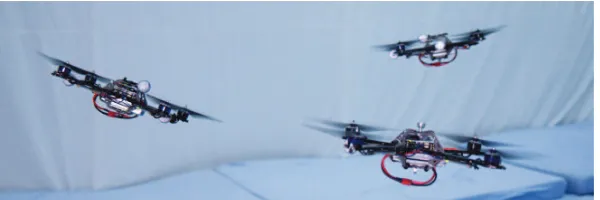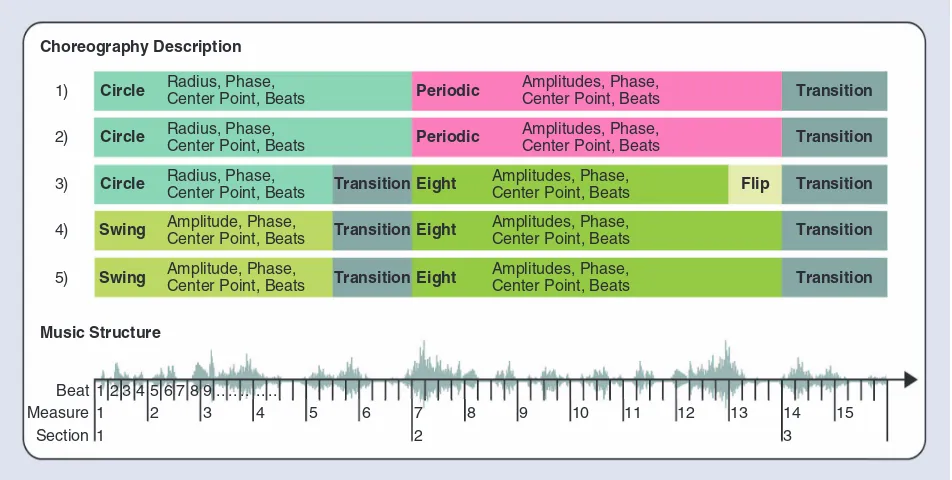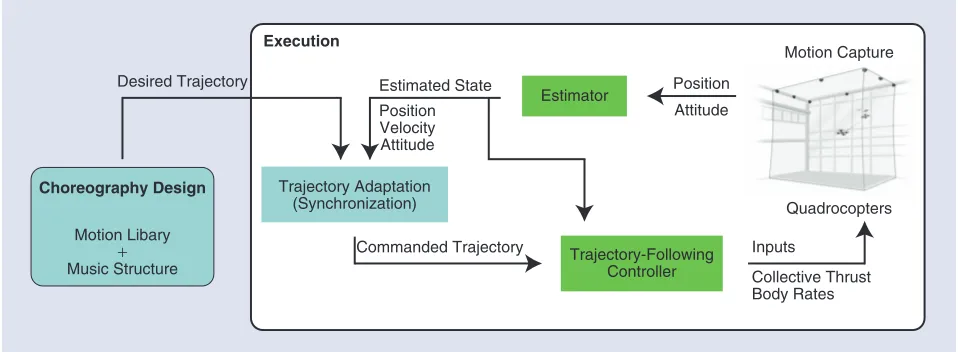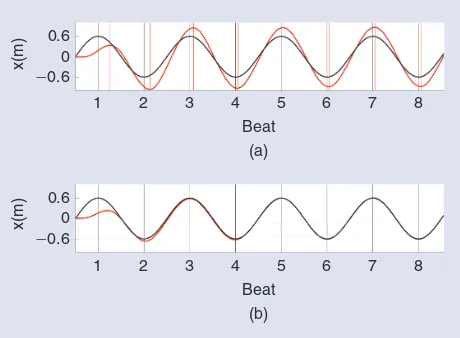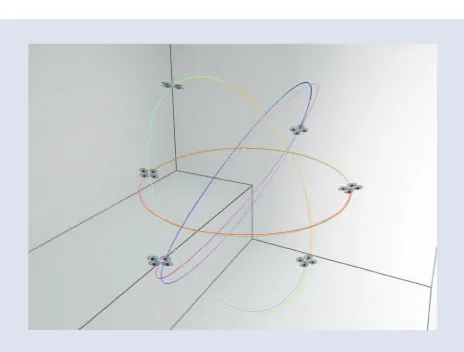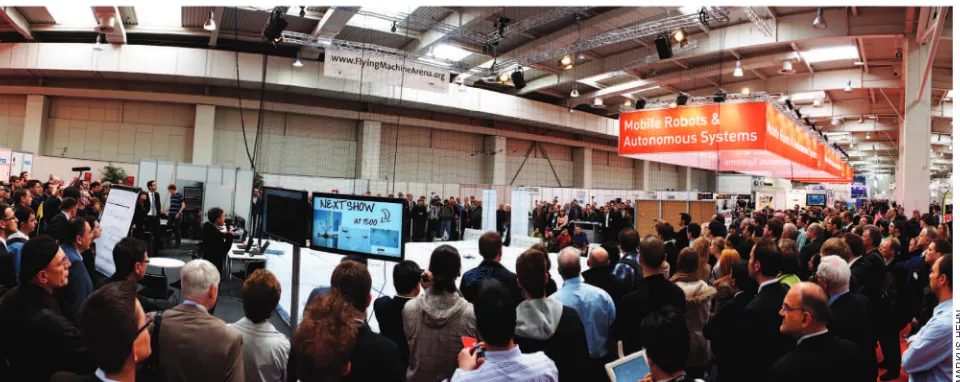Date of publication: 30 October 2013
I
magine a troupe of dancers flying together across a big open stage, their movement choreographed to the rhythm of the music. Their performance is both coordinated and skilled; the dancers are well rehearsed, and the choreogra-phy well suited to their abilities. They are no ordinary dancers, however, and this is not an ordinary stage. The per-formers are quadrocopters, and the stage is the ETH Zurich Flying Machine Arena, a state-of-the-art mobile testbed for aerial motion control research (Figure 1).Quadrocopters are exceptionally agile vehicles, but it takes more than agility to successfully perform a coordinated flight choreography to music. From trajectory generation and syn-chronization to motion feasibility and collision-free flight, this article describes our efforts to create a robotic musical flight performance that is both viable and convincing.
Let us begin, however, with a discussion on the emer-gence of a new field of research that has grown out of the overlap between music and robotics. The workshop held at the 2010 IEEE/Robotics Society of Japan (RSJ) International Conference on Intelligent Robots and Systems (IROS) titled “The First IROS Workshop on Robots and Musical Expres-sions” [1] bridged the worlds of robotics, music information
By Federico Augugliaro, Angela P. Schoellig, and Raffaello D’Andrea
Dance of the
Flying Machines
Dance of the
Flying Machines
Methods for Designing and Executing
an Aerial Dance Choreography
© ISTOCKPHOTO.COM/VISUALGO
retrieval, and the cognitive sciences. The workshop was evi-dence that the overlap of these once-distinct fields is becom-ing a prominent area of research for musicians and roboti-cists alike and has resulted in both novel human–robot interplay and unique musical experiences. Research on musi-cal robots from the past decade can, for the most part, be characterized by the background of the researchers. Musi-cians, composers, and music technologists have generally sought to develop innovative forms of musical expression and sound production that overcome the limitations of human music generation and traditional musical instru-ments. Recently, this group has been behind the develop-ment of perceptual music robots, some of which facilitate music collaboration with human musicians [2], [3].
Roboticists, on the other hand, have sought to use music to establish a new dimension of human–robot communica-tion, interaccommunica-tion, and collaboration. Research from this sec-ond community has been largely focused on the develop-ment of humanoid robots capable of imitating human musical behavior: robots that perform human-inspired rhythmic motions, such as dancing, drumming, stepping, and singing along to music [4]–[7]. Common to both com-munities is the desire to create an audio-visual performance with both aesthetic and entertainment values. So far, most of the research on dancing robots has focused on humanoid robots. Only recently have two artistic performances fea-tured quadrocopters on stage with human actors/dancers [8], [9]; these focused on the interplay between humans and machines and had skilled human operators controlling the quadrocopters.
This article describes how to generate a choreography for flying vehicles and considers the composition and autonomous execution of multivehicle rhythmic flight. The music is analyzed ahead of time to obtain a description of the music’s structure. The pre-extracted music beat is cho-sen as the basic unit of the music structure and serves as a reference for rhythmic movements. The trajectories are predesigned and parameterized, providing a flexible and customizable library of motion primitives. These basic ele-ments are then concatenated and assigned to different music sections by the user, using the underlying music description to guide the choreography design. This process is done with the help of a customized software tool and is conceptually shown in Figure 2. To complement the design process, we also developed a numerical test that assesses the feasibility of desired trajectories. This
article focuses on quadrocopters, but many components may be applied to other robots and flying vehicles.
In this article, we first explain the key methods and strategies used to generate an aerial choreography. We then highlight spe-cific issues related to the use of quadrocop-ters and multiple flying vehicles for dance performances. This is followed by a tutorial-like explanation that guides the reader
through the generation of a choreography for multiple vehi-cles. We conclude with a summary of our experimental results. A video featuring multiple quadrocopters dancing to music can be seen as a complement to this article in IEEE Xplore.
Dancing Quadrocopters
Quadrocopters are exceptionally agile aerial vehicles. Capable of vertical takeoff and landing, these vehicles can perform fast motions in the translational and rotational degrees of freedom. These characteristics, and the vehicles’ inherent symmetric design, make
quadrocopters a suitable platform for executing an aerial dance, where expres-siveness in motion and temporal variety is the key. However, unlike human dancers or humanoid robots, quadrocopters do not have limbs: their expressiveness is based solely on their position and attitude in space over time. Consequently, find-ing motion patterns that are convincingly expres-sive to the human eye is not trivial.
Four fundamental choreographic elements: 1) space, 2) time, 3) weight, and 4) flow are commonly used by cho-reographers and dance teachers to build choreography with interest, dynamics, and aesthetic appeal [10], [11]. These parameters provide a framework for meaningful quadro-copter choreography and are described as follows: 1) space refers to the area the dancer is performing in and also relates to how the dancer moves through the area, as char-acterized by the direction and path of a movement, as well as its size, level, and shape; 2) time encompasses rhythm, tempo, duration, and phrasing of movements;3) weight relates to the quality of movement, as some types of chore-ographies are soft and smooth whereas others are sharp and energetic; and 4) flow represents the organization of movement sequences into larger concepts: the combination and variation of movements using recurring elements, con-trast, and repetition.
Figure 1. A dance performance of multiple quadrocopters in the Flying Machine Arena.
FEDERICO A
UGUGLIAR
O
Quadrocopters are
exceptionally agile vehicles,
but it takes more than
agility to successfully
perform a coordinated
flight choreography
In the following sections, we explain how we arrive at a choreographed quadrocopter dance performance. We first present our motion library, from which we extract viable motions for the performance. We then introduce a basic description of music that serves as a reference when designing a new choreography. Finally, we explain the strategies we use for linking the motion to the music.
Motion Library
Motion primitives are the key building blocks of our chore-ographies: they represent well-defined motions of a quadro-copter during a finite period of time. The concatenation of motion primitives defines the vehicles’ trajectories during the whole performance. The motion primitives are parameter-ized, categorparameter-ized, and stored in the motion library to be later combined into a variety of choreographic designs.
Quadrocopters possess six degrees of freedom. However, since their dynamics are differentially flat, all states and inputs of the system can be expressed in terms of a set of out-puts and their derivatives [12]. One of these sets consists of the three-dimensional (3-D) position of the vehicle and its heading, given by the yaw angle [13]. Therefore, the motion primitives considered in this article are described by their position trajectory in 3-D space and by a yaw trajectory pro-file, which can be independently specified. These terms fully specify the vehicle’s position and attitude.
The trajectories are input to an underlying trajectory-fol-lowing controller that computes the necessary inputs to the vehicle based on its current state. Adaptation techniques are used to synchronize the quadrocopter trajectory to the music
beat and to achieve precise trajectory tracking (see the “Syn-chronization” section). The overall system setup is outlined in Figure 3.
Three different kinds of motions can be used to describe the motion trajectories in this article: 1) periodic motions, 2) acrobatic motions, and 3) transition motions. Periodic motions are strictly linked to the music beat, whereas acro-batic motions are thought to be aesthetic highlights. Finally, transition motions allow for smooth transitions between dif-ferent motion primitives.
Periodic Motion Primitives
Periodic motion is a natural human response to a recurring beat: we often clap, sway, or tap our feet when we hear music. Thus, we want the flying vehicle to mimic this behavior. For our purpose, the trajectory of a periodic motion primitive is represented by a sum of sines and cosines
,
where the frequency X is related to the music beat. The cen-ter point ,x0 the amplitudes ck and dk (all vectors in R3), and the phase { are design parameters. Trajectories with different
frequency components are combined if N is chosen to be greater than 1.
The above formulation is mathematically redundant but allows us to easily define a multitude of periodic motion primitives using a set of intuitive design parameters. For example, a circle of radius r in the horizontal plane can be
Choreography Description
Music Structure
Section Measure Beat
Circle Radius, Phase,Center Point, Beats
Radius, Phase,
defined by choosing c1=^r, ,0 0h and d1=^0, , ,r0h whereas
{ sets the starting position. Notice that these design
parame-ters can be directly linked to the fundamental choreographic elements described above. The variables ,ck dk, x0, and {
refer to the space, and X refers to the time. The number N is related to the weight: the higher the value, the more energetic and sharp are the possible motions.
To speed up and ease the choreography design phase, some commonly used periodic motions (e.g., circle, swing, and figure eight) are included separately in the motion library with a con-venient customized interface, as shown in Figure 2.
Acrobatic Motions
To increase the variety of our motions in the performance, we include choreographic highlights such as flips, loopings, or bang-bang-type transitions, some of which require cutting-edge research in areas such as aerial control and adaptation/learning [14]. These motions add aesthetic and technical varieties to the performance even though they are not strictly related to the music beat.
Transition Motions
A choreography is created by concatenating motion primi-tives from the motion library. However, to avoid jumps in the quadrocopter’s attitude, the trajectory must be continuous up to the acceleration. Smooth transitions between consecutive motion primitives are therefore essential for a proper execu-tion. Although assigning individual motion primitives to many vehicles without creating intersections is relatively sim-ple (for examsim-ple, placing them on the same circle by varying the phase parameter), transitioning between multiple motion primitives while avoiding collisions is more complicated. Therefore, we developed a method for generating collision-free trajectories for multiple vehicles from a set of initial states (specified by position, velocity, and acceleration) to given final states. The trajectories satisfy various constraints,
including the physical limits of the vehicle, space boundaries, and a minimum distance between vehicles. The general idea of the transition algorithm is described in the section “Colli-sion-Free Motions.”
Music Description
Most music pieces have a well-defined time structure, and because beat times are a key characteristic of this structure, we use them as the basic
unit of the choreography (Figure 2). Using publicly available beat extraction software, we analyze the music to determine beat locations. Periodic quadro-copter motions are then automatically synchro-nized to the music beat. Measure information fol-lows from the music time signature. In future itera-tions, this simple time structure may be extended
by considering additional features of music, such as its mood or its relative loudness (dynamic range). This will ease the choice of motion primitives (and their parameters) and will eventually lead to an automatic generation of music-driven trajectories, where the elements of the motion library are shaped and concatenated according to the music’s features.
Linking Motion and Music
Connecting vehicle motion to music is key to a rhythmic flight performance, as it is this link that transforms movement into dance. We face two main obstacles as we seek to link motions from the library with each section of music.
Execution
Desired Trajectory
Position Velocity Attitude
Commanded Trajectory
Estimated State Position
Attitude
Motion Capture
Quadrocopters
Choreography Design
Motion Libary + Music Structure
Trajectory Adaptation (Synchronization)
Estimator
Trajectory-Following Controller
Inputs
Collective Thrust Body Rates
Figure 3. The high-level system architecture used to design and execute dance choreographies with quadrocopters. The key blocks (gray) are the choreography design stage and the trajectory adaptation techniques. The other blocks depict commonly used infrastructure of our testbed.
Roboticists, on the other
hand, have sought to use
music to establish a new
dimension of human–robot
communication, interaction,
Periodic Motion Primitives and Music Beat
To achieve a recognizable dance behavior, periodic motion primitives are linked to the music beat. The frequency X
from (1) is directly given by the music beat or a multiple of it. A simple example is shown in Fig-ure 4: the quadrocopter performs a planar swing motion where, at beat times, the vehicle reaches the outermost points of the trajectory, either on the left or right.
However, experimental results have shown that, at steady state, the quadrocopter response to a periodic sinusoi-dal input is a sinusoisinusoi-dal motion of the same frequency with a constant error in amplitude and phase, resulting in asyn-chrony, as shown in Figure 5(a). To achieve precise temporal and spatial tracking, we adapt the parameters of the com-manded trajectory sent to the trajectory-following controller with correction terms (Figure 3). A more detailed explanation of this approach is provided in the “Synchronization” section.
Design Parameters
Any of the library’s motion primitives can be readily shaped to better fit the underlying music by adapting the motion param-eters, e.g., , , ,x c d0 k k and { for periodic motion primitives (1).
However, the resulting trajectories must satisfy vehicle feasibil-ity constraints, e.g., the propeller forces required to fly a trajec-tory must not exceed the vehicle’s motor capabilities. The choice of the design parameters is thus not completely free. We have developed various methods for assessing the fea-sibility of a trajectory, the underlying principles of which are summarized in the “Motion Feasibility” section.
Some Insights
This section presents algorithms and methods that are funda-mental to the generation of a multiple-quadrocopters dance performance. Interested readers can find detailed explana-tions in [15], [16], and [18]–[20].
Synchronization
As introduced previously, the quadrocopter’s response to a desired periodic sinusoidal input exhibits a constant phase shift and amplitude error. As a result, the quadrocopter’s motion is perceived as out of tempo with the music.
The phase lag of the quadrocopter’s response was first identified and corrected for in [15] for the unidirectional case of a swing motion (Figure 4). Figure 5(a) shows the actual quadrocopter trajectory (in red) and the desired one (in black). The amplitude error of the quadrocopter response is obvious; the phase error between the desired trajectory and the actual quadrocopter response seems neg-ligible. However, small phase errors are perceivable to the human eye in the actual experiments. Depending on the motion frequency, we observe delays of up to 115 ms [16]. Cognitive science literature states that audio–video asyn-chrony can be perceived when the audio leads the video by as little as 29 ms [17].
Our strategy for coping with the aforementioned con-stant phase shift and amplitude error is to adjust the motion parameters of the trajectory commanded to the underlying trajectory-following controller. This means, for example, that if the amplitude of the quadrocopter motion is larger than the desired one, we reduce the commanded amplitude. Similarly, if the vehicle motion is lagging, we shift the commanded trajectory by increasing the phase. The proposed adaptation strategy entails feedforward cor-rection terms, which are obtained from an offline identifi-cation and a method for correcting for residual errors online while performing the motion. With preidentified feedforward correction terms, the tracking errors during the initial transient phase become negligible; this is espe-cially the case if the vehicle’s initial state corresponds to the desired one. Thus, the vehicle tracking performance is con-vincing to the human observer. Figure 5(b) shows the quadrocopter trajectory when using this method: the peri-odic trajectory is tracked correctly. This approach is described in detail in [16].
Beat
Figure 5. The unidimensional swing motion with a frequency of 0.62 Hz. The quadrocopter starts at zero velocity. (a) The quadrocopter response (in red) to a desired oscillation in the x-direction (in black). The vertical lines indicate the peak values and show the phase error. Amplitude errors in the quadrocopter response are also observed. (b) The quadrocopter trajectory when applying the adaptation methods described in the “Synchronization” section. Phase and amplitude errors are compensated for.
Beat Beat
Figure 4. A periodic swing motion. The goal is to have the music beats occur at the outermost points of the movement.
The concatenation of
motion primitives defines
the vehicles’ trajectories
during the whole
Motion Feasibility
Not every desired trajectory is feasible. For quadrocopters, motor capabilities (minimum and maximum thrust) and sensor limitations (maximum rotational rates) constrain the range of feasible motion primitives. In [18], feasible parameter sets for parameterized motion primitives a priori to flight experiments are identified. Figure 6 shows the fea-sible parameter sets (radius and frequency) for a planar cir-cle. This provides guidelines for the choreography genera-tion step and will also facilitate a future automatic generation of motion primitives by providing the algorithm with a clear set of rules regarding the feasibility of parame-terized motion primitives.
These results were recently extended to numerically assess the feasibility of arbitrary quadrocopter trajectories [19]. Before actual flight, the feasibility of a created motion sequence is evaluated. Using a first-principles model of the vehicle dynamics, a numerical method relates a desired trajectory to the required vehicle rota-tional rates and propeller forces. The obtained values must meet vehicle constraints caused by actuator and sen-sor limitations.
Collision-Free Motions
In the context of multivehicle flight, we developed an algorithm that moves a group of vehicles from one config-uration to another one without collisions [20]. These tra-jectories are used to generate smooth transitions between consecutive motion primitives before actual flight and for safely coordinating multiple vehicles during takeoff, land-ing, and in unexpected situations. This method returns collision-free trajectories for multiple vehicles within a few seconds.
The goal is to generate trajectories for transitioning from a set of initial states (position, velocity, and acceleration of each vehicle) to a set of final states in a given time, while sat-isfying simple dynamic constraints and guaranteeing a min-imal distance between vehicles, as shown in Figure 7 for a two-dimensional scenario. We formulate our multivehicle trajectory planning problem as a constrained optimization problem. We use an approach called sequential convex
pro-gramming [21], which recursively solves the problem by
approximating the nonconvex constraints (minimum dis-tance between vehicles) by convex ones. A video demon-strating the algorithm can found online at http://youtu.be/ wwK7WvvUvlI.
Generating a Choreography
In this section, we show how a choreography featuring mul-tiple quadrocopters can be created using our existing setup. A video of the resulting flight performance can be found on the project’s Web site [22].
Music Analysis
Our first step is to choose a piece of music and pro-cess its audio file with beat extraction software. We use Beatroot [23] for this purpose. The beat times are extracted auto-matically and serve as the basic unit of the music time structure. Sections are identified manually
Figure 6. Feasible parameter sets for a circular motion primitive in the horizontal plane. Parameter combinations of the dark gray region are infeasible due to motor limitations. For example, if we want to perform a circle every second (6.28 rad/s), its maximum radius cannot exceed 0.38 m, as shown by the red circle. More details can be found in [18].
Frequency (rad/s)
Feasible Infeasible
Radius (m)
8 10 12 14 16 18
2 4 6
0 0.5 1 1.5 2
0
Figure 7. The collision-free transition motion demonstrated for a two-dimensional scenario. The circles show the positions of the vehicles (and the required minimum distance) in the xy-plane at subsequent times from left to right. The lines indicate the resulting trajectories.
Adaptation techniques
are used to synchronize
the quadrocopter trajectory
to the music beat and
to achieve precise
by listening to the music. We use this description later when designing the choreography. We store the informa-tion in a text file, where B1 represents the first beat of the music piece and S1 the beginning of section number one. Each tag is time stamped, i.e., B4 may refer to t=2s of the music piece.
Choreography Design
We developed a software tool and an intuitive scripting lan-guage to ease the choreography design. In this section, we demonstrate its use by creating a choreography for four vehi-cles and present excerpts from the text file containing the scripted choreography.
First, we assign a swing motion to all quadrocop-ters, from beat 1 to the beginning of section 2 of the music piece. This motion uses the periodic m o t i o n f r a m e w o r k described in (1), but has a specialized interface (Fig-ure 2). We assign this motion to vehicle 1 with
B 1 - S 2 , 1 , S W I N G, a m p = 0 . 6 , c e n t e r = [-1.5;-1;3], beats=4;.
The parameter center refers to ,x0 amp indicates the
amplitude of the motion. We want the vehicle to complete a full period of the motion every four beats (beats=4).
The swing motion is followed by a bounce motion for all vehicles. This motion is created by exploiting the gen-eral framework for periodic motion primitives. The matri-ces C and D contain the vectors ck and ,dk phi refers to {
S3-S4, 1, PERIODIC, C=[1 0;1 0;0 -0.5], D=[0 0;0 0;0 0], center=[1;1;5], phi=0,
beats=8.
Note, however, that the swing motion and the bounce motion take place at different locations in space. To smoothly concatenate the two motion primitives and, at the same time, ensure collision-free trajectories for every vehicle, we use the algorithm illustrated in the “Colli-sion-Free Motions” section. A collision-free transition is planned from the final states of the previous motion primitive (swing) to the initial states of the next one (bounce), guaranteeing a smooth acceleration profile and safe trajectories
S2-S3, 1, TRANSITION; S2-S3, 2, TRANSITION; S2-S3, 3, TRANSITION; S2-S3, 4, TRANSITION;.
The same algorithm is also used to transition to the next motion of our example choreography, a circle. We take advan-tage of the parameters phi to place multiple vehicles on the same circle, by varying the phase {only
S5-S6, 1, CIRCLE, radius=2.5, center= [0;0;3], phi=0, beats=8;
S5-S6, 2, CIRCLE, radius=2.5, center= [0;0;3], phi=1.57, beats=8; S5-S6, 3, CIRCLE, radius=2.5, center=
[0;0;3], phi=3.14, beats=8; S5-S6, 4, CIRCLE, radius=2.5, center=
[0;0;3], phi= –1.57, beats=8;.
Finally, we transition to the final motion, a flip, which is taken from the acrobatic motion primitives set. The total ver-tical displacement for this motion is indicated by
S8-B70, 1, FLIP, h=3;.
The multimedia accompanying this article in IEEE Xplore shows a video of the actual flight performance.
Assess the Feasibility
Numerical Test
Once the choreography has been designed, the feasibility of the trajectories must be assessed. Thus, we check numerically whether the desired trajectories satisfy motor and sensor constraints (see the “Motion Feasibil-ity” section). We also verify that the trajectories are inside our flyable space and that a minimum distance between quadrocopters is ensured throughout the per-formance to prevent collisions.
Simulation
In addition to checking the desired trajectories for feasibility, we also simulate the flight behavior with our standard simula-tor. This encompasses additional dynamic effects (e.g., motor dynamics) and various noise sources, and considers the dynamic response of the trajectory-following controller. The simulator also provides a 3-D environment for evaluating the choreography, as shown in Figure 8.
Figure 8. The Flying Machine Arena simulation environment, showing part of a choreography. The lines indicate the flown trajectories and help the user to visually assess the choreography.
The beat times are
extracted automatically and
serve as the basic unit of
Fly
The very same infrastructure, software, and network commu-nication is then used to actually fly the designed choreogra-phy in the ETH Zurich Flying Machine Arena. The straight-forward transition from simulation to actual experiments is enabled by the software architecture of the testbed and by the accuracy of the simulation.
Performances in the Flying Machine Arena
Experimental Testbed
We demonstrate our algorithms on small custom quadro-copters operated in the ETH Zurich Flying Machine Arena, a 10 # 10 # 10 m3 mobile testbed for quadrocopter research. The system features a motion capture system that provides precise vehicle position and attitude measure-ments. The localization data is sent to a personal computer, which runs control algorithms and sends commands to the quadrocopters at +50 Hz. A suite of software tools, algo-rithms, and components (such as the underlying trajectory-following controller) support the testbed, allowing for a rapid transition of algorithms from simulation to the real vehicles. More details on the testbed can be found in [14] and at www.FlyingMachineArena.org.
Choreographies
Since the start of the project, several choreographies have been designed and regularly demonstrated. The following list pres-ents the choreographies that are featured in the Flying Machine Arena with the song name, the singer or composer, the number of quadrocopters, and their respective design year:
● Please Don’t Stop the Music, Rihanna, one quadrocopter,
2009
● Pirates of the Caribbean, Hans Zimmer, two quadrocopters, 2009
● Rise Up, Yves Larock,three quadrocopters, 2010
● From the Clouds, Jack Johnson, four quadrocopters, 2011
● Armageddon, Prism, five quadrocopters, 2011
● Dance of the Flying Machines, Victor Hugo Fumagalli, six
quadrocopters, 2013.
These choreographies have been performed not only at ETH Zurich, where we conduct our research, but also at exhi-bitions such as Google I/O (June 2012) and the Hannover Messe (April 2012) (Figure 9). A video showing six quadro-copters dancingto Dance of the Flying Machines demonstrates the system capabilities and can be seen as a complement to this article in IEEE Xplore.
Implementation
The resulting performance is completely preprogrammed. However, to allow for a robust and reliable execution, adapta-tion schemes are used at several points. Because of the colli-sion-free method presented in the “Collision-Free Motions” section, takeoff and landing with multiple vehicles can be executed from arbitrary vehicle positions. When executing a performance, the quadrocopters are put into the flying space at random locations, and the algorithm plans collision-free trajectories to the starting points of the choreography within seconds. Furthermore, as explained in the “Synchronization” section, residual phase and amplitude errors in the quadro-copter response are compensated for during the performance by adapting the commanded trajectory online. The online adaptation allows us to synchronize the motion of vehicles with slightly different dynamic properties (e.g., shifted center of mass and degraded propellers).
Conclusions
This article demonstrated the design and execution of dance performances with multiple quadrocopters. It provided an overview of the various components we use to design chore-ographies that are timed to music. We proposed a trajectory design based on the concatenation of different motion primi-tives, and introduced transition motions for smooth concate-nations and for the collision-free coordination of multiple Figure 9. The ETH Zurich Flying Machine Arena at the Hannover Messe in Germany, the world’s largest industrial fair (April 2012).
vehicles. Methods for precisely synchronizing the quadro-copter motion to the music beat, and for assessing the feasi-bility of the desired trajectories were also presented. Finally, the “Generating a Choreography” section guided the reader through the generation of an actual choreography. This arti-cle includes a video in IEEE Xplore featuring multiple quadrocopters dancing to music.
It is our hope that these methods and tools will facilitate the development of a (semi)automatic generation of chore-ographies, where motion primitives are chosen automati-cally to reflect the music’s character [24]. The automatic choice of appropriate motion primitives parameters is still open: they will be selected according to a richer description of the music from a set of feasible parameters given by our feasibility assessment tools. Additional future steps include the expansion of the motion library and the automatic incorporation of audience feedback during the choreogra-phy design phase.
Acknowledgments
We would like to acknowledge the contributions of the cur-rent and former Flying Machine Arena team members, in particular, Markus Hehn, Sergei Lupashin, Mark W. Mueller, and Michael Sherback. We also would like to thank Marc-Andre Corzillius, Carolina Flores, Hans Ulrich Honegger, and Igor Thommen for the technical support and Philipp Reist and Hallie Siegel for their suggestions on the manuscript. This research was supported in part by the Swiss National Science Foundation.
References
[1] The First IROS 2010 Workshop on Robots and Musical Expressions. (2010). Proc. IROS Workshop Robots Musical Expressions [Online]. Available: http:// winnie.kuis.kyoto-u.ac.jp/RMEWS/proc/
[2] G. Hoffman and G. Weinberg, “Interactive improvisation with a robotic marimba player,” Auton. Robots, vol. 31, nos. 2–3, pp. 133–153, 2011.
[3] A. Lim, T. Mizumoto, T. Ogata, and H. G. Okuno, “A musical robot that synchronizes with a coplayer using non-verbal cues,” Adv. Robot., vol. 26, nos. 3–4, pp. 363–381, 2012.
[4] D. Grunberg, R. Ellenberg, I. H. Kim, J. H. Oh, P. Y. Oh, and Y. E. Kim, “Development of an autonomous dancing robot,” Int. J. Hybrid Inform. Tech-nol., vol. 3, no. 2, pp. 33–44, 2010.
[5] J. Oliveira, L. Naveda, F. Gouyon, L. Reis, P. Sousa, and M. Leman, “A parameterizable spatiotemporal representation of popular dance styles for humanoid dancing characters,” EURASIP J. Audio, Speech, Music Processing, vol. 18, pp. 1–14, June 2012.
[6] K. Murata, K. Nakadai, K. Yoshii, R. Takeda, T. Torii, H. G. Okuno, Y. Hasegawa, and H. Tsujino, “A robot uses its own microphone to synchronize its steps to musical beats while scatting and singing,” in Proc. IEEE/RSJ Int. Conf. Intelligent Robots Systems, Sept. 2008, pp. 2459–2464.
[7] J.-J. Aucouturier, “Cheek to chip: Dancing robots and AI’s future,” IEEE Intell. Syst., vol. 23, no. 2, pp. 74–84, 2008.
[8] R. Murphy, D. Shell, A. Guerin, B. Duncan, B. Fine, K. Pratt, and T. Zourn-tos, “A Midsummer Night’s Dream (with flying robots),” Auton. Robots, vol. 30, no. 2, pp. 143–156, 2011.
[9] P. Catton. (2011, July). Culture city online: Dances with robots [Online]. Available: http://blogs.wsj.com/metropolis/2011/07/15/culture-city-online-dances-with-robots/
[10] J. Newlove and J. Dalby, Laban for All. London: Nick Hern Books, 2003. [11] A. LaViers and M. Egerstedt, “Style based robotic motion,” in Proc. Ameri-can Control Conf., June 2012, pp. 4327–4332.
[12] M. Fliess, J. Lévine, P. Martin, and P. Rouchon, “Flatness and defect of non-linear systems: Introductory theory and examples,” Int. J. Control, vol. 61, no. 6, pp. 1327–1361, 1995.
[13] D. Mellinger and V. Kumar, “Minimum snap trajectory generation and control for quadrotors,” in Proc. IEEE Int. Conf. Robotics Automation, May 2011, pp. 2520–2525.
[14] S. Lupashin and R. D’Andrea, “Adaptive fast open-loop maneuvers for quadrocopters,” Auton. Robots, vol. 33, nos. 1–2, pp. 89–102, 2012.
[15] A. P. Schoellig, F. Augugliaro, S. Lupashin, and R. D’Andrea, “Synchroniz-ing the motion of a quadrocopter to music,” in Proc. IEEE Int. Conf. Robotics Automation, May 2010, pp. 3355–3360.
[16] A. P. Schoellig, C. Wiltsche, and R. D’Andrea, “Feed-forward parameter identification for precise periodic quadrocopter motions,” in Proc. American Control Conf., June 2012, pp. 4313–4318.
[17] S. van de Par and A. Kohlrausch, “Sensitivity to auditory-visual asyn-chrony and to jitter in auditory-visual timing,” in Proc. SPIE 3959, Human Vision Electronic Imaging V, June 2000, pp. 234–242.
[18] A. P. Schoellig, M. Hehn, S. Lupashin, and R. D’Andrea, “Feasibility of motion primitives for choreographed quadrocopter flight,” in Proc. American Control Conf., June 2011, pp. 3843–3849.
[19] F. Augugliaro, “Dancing quadrocopters—Trajectory generation, feasibility and user interface,” M.S. thesis, Inst. Dyn. Syst. Control, ETH Zurich, Zurich, Switzerland, 2011.
[20] F. Augugliaro, A. P. Schoellig, and R. D’Andrea, “Generation of collision-free trajectories for a quadrocopter fleet: A sequential convex programming approach,” in Proc. IEEE/RSJ Int. Conf. Intelligent Robots Systems, Oct. 2012, pp. 1917–1922.
[21] S. Boyd. (2008). Sequential convex programming (Lecture Notes), Stan-ford Univ., StanStan-ford, CA. [Online]. Available: http://www.stanStan-ford.edu/class/ ee364b/lectures/seq_slides.pdf
[22] (2013). Music in Motion. Inst. Dyn. Syst. Control, ETH Zurich, Zurich, Switzerland. [Online]. Available: http://www.idsc.ethz.ch/Research_DAndrea/ Music_In_Motion
[23] S. Dixon, “Evaluation of the audio beat tracking system Beatroot,” J. New Music Res., vol. 36, no. 1, pp. 39–50, 2007.
[24] G. Xia, J. Tay, R. Dannenberg, and M. Veloso, “Autonomous robot danc-ing driven by beats and emotions of music,” in Proc. 11th Int. Conf. Autono-mous Agents Multiagent Systems, June 2012, pp. 205–212.
Federico Augugliaro, Institute for Dynamic Systems and Con-trol, Department of Mechanical and Process Engineering, ETH Zurich, Switzerland. E-mail: [email protected].
Angela P. Schoellig, Institute for Aerospace Studies, University of Toronto, Canada. E-mail: [email protected].
